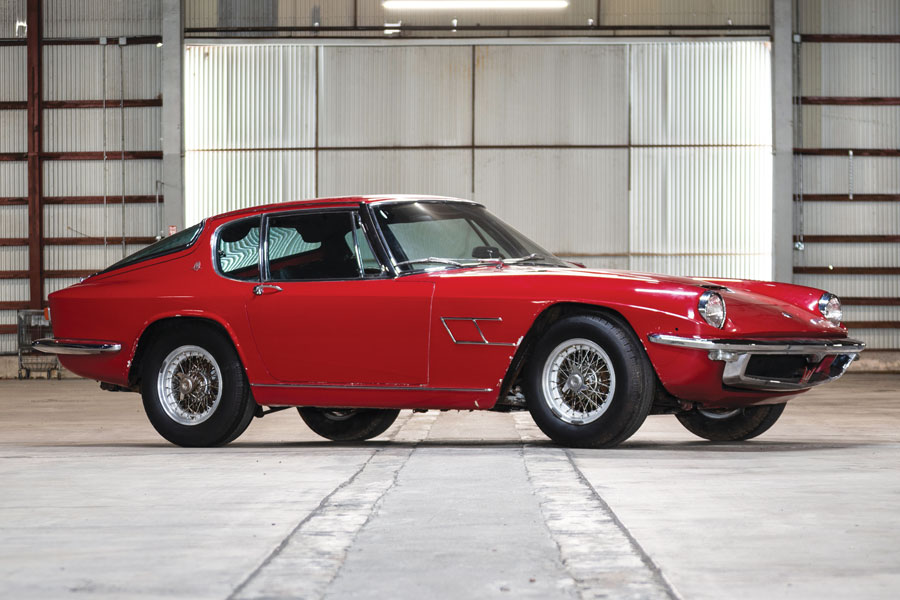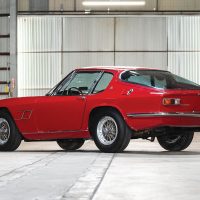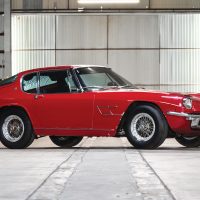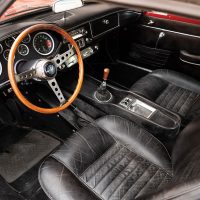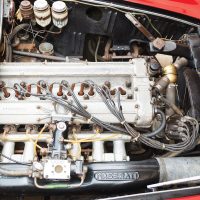SCM Analysis
Detailing
| Vehicle: | 1967 Maserati Mistral 4.0 Alloy Coupe by Frua |
| Years Produced: | 1964–70 |
| Number Produced: | 828 |
| Original List Price: | $21,000 |
| SCM Valuation: | $132,000 |
| Tune Up Cost: | $3,500 |
| Chassis Number Location: | Engine compartment on side rail |
| Engine Number Location: | Stamped on side of block |
| Website: | http://www.maseratinet.com |
| Alternatives: | 1963–65 Aston Martin DB5, 1961–64 Lancia Flaminia Sport, 1966–68 Lamborghini 400 GT 2+2 |
| Investment Grade: | C |
 This car, Lot 172, sold for $62,500, including buyer’s premium, during RM Sotheby’s Online Only “Driving Into Summer” auction from May 21 to 29.
This car, Lot 172, sold for $62,500, including buyer’s premium, during RM Sotheby’s Online Only “Driving Into Summer” auction from May 21 to 29.
When I first discovered my love of cars as a boy, the Frua-designed and -built Maseratis — the Mistral and the Quattroporte — were among my first loves. So they remain today, for me a perfect expression of effortless Italian chic and glamour. They combine a sense of elegance and strength which is difficult to pull off, yet another physical expression of the virtually untranslatable word “sprezzatura.”
That this car, a non-running project, was offered in this online-only RM Sotheby’s auction was also an interesting thing. For the past decade or so, the traditional auction houses shunned project cars, unless they were “barn fresh” — an oxymoron if there ever were one — replete with nests, webs, dust, dirt and decay. At the same time, the online-auction market channel offered an ideal place to sell a car with needs.
A very long and detailed written description, revealing each and every possible fault or demerit, accompanied by many dozens of photos showing in excruciating close-up individual warts and blemishes, was just what was needed to successfully portray a car in need of rescue, resurrection or restoration. In the major auction sales rooms, it was freshly gleaming paint, chrome, leather and glass that was needed under the perfectly aimed pin spotlights.
Back under the spotlights
So here we had an undeniable beauty queen from the late Via Veneto period — just before the advent of student strikes and the Red Brigades — somewhat down on her luck having spent a few years locked away in hiding from her fans, fearful of the way she might be perceived in her middle age. Embraced by the “big time” auction house as had been her more glamorous friends, how would she be received?
Well, the answer was perhaps better than expected. The Mistral was treated with a great deal of respect, but ultimately, I think perhaps not as much honesty as was deserved. To prepare for inclusion in this sale, it was clear from the photos online that a great deal of time and effort had been spent cleaning and detailing the car inside and out.
Nothing is wrong with that, as I am not a fan of the “tetanus car” presentation. A vehicle should be shown to its best advantage, without quick-and-dirty fluffing. However, for an online auction, the exterior shots could have been quite a bit less artsy and rather more documentary in feel. Only one of the posted photos had been taken outside, the rest inside a warehouse with somewhat dramatic lighting which flattered the car’s appearance.
The interior looked beautifully patinated, with just the right level of wear showing to give a gentlemen’s-club feel. In the car’s favor, detail shots of the exterior clearly showed areas of electrolytic corrosion bubbling along the wheelarches, which is typical and expected in a car such as this that has been parked in storage for an extended time. Also evident in the photographs of the engine compartment were the effects of the layup in the surface rust and corrosion on the metal surfaces and hoses.
It was also heartening to see that the Mistral retained its Lucas fuel injection, which was often discarded in the past in favor of carburetors. The Lucas systems are now readily rebuildable and can be made more reliable than when the cars were new. In my opinion, when properly set up, the injection suits the engine’s power curve well and provides a smooth and even delivery through the range, which is well suited to the character of the Mistral.
Many needs equals low bids
The pre-sale estimate of $90,000–$110,000 might have seemed reasonable compared to an SCM Pocket Price Guide median value of $132,000 and other recent sales in a similar range for average cars with older restorations, but the price realized is more representative of the current marketplace — in which the active money for cars is at a very competitive level.
The best examples of any particular car can and do bring record high prices — even in the COVID-19 environment — while projects such as this — or cars with cloudy stories — bring vastly discounted ones.
In this case, based on the vehicle as judged by the description and photographs, this car seems to be a fairly good deal. After figuring in the need to completely rebuild the mechanicals and a minimal cosmetic intervention, the new owner would not be too far underwater.
And, for the enjoyment of driving this superbly elegant grand tourer, the new owner’s “loss” is certain to be repaid in the experience of ownership. ♦
(Introductory description courtesy of RM Sotheby’s.)
